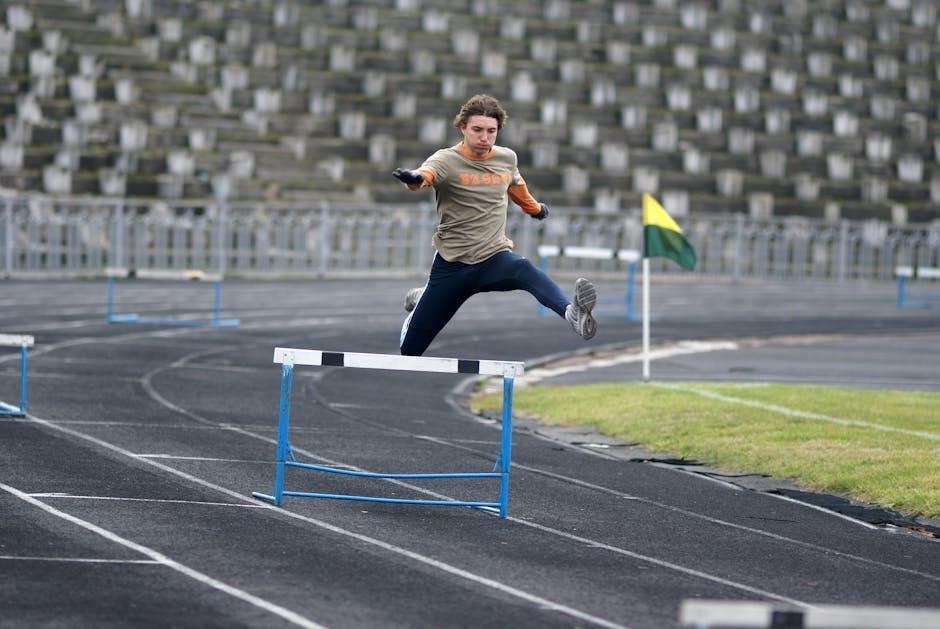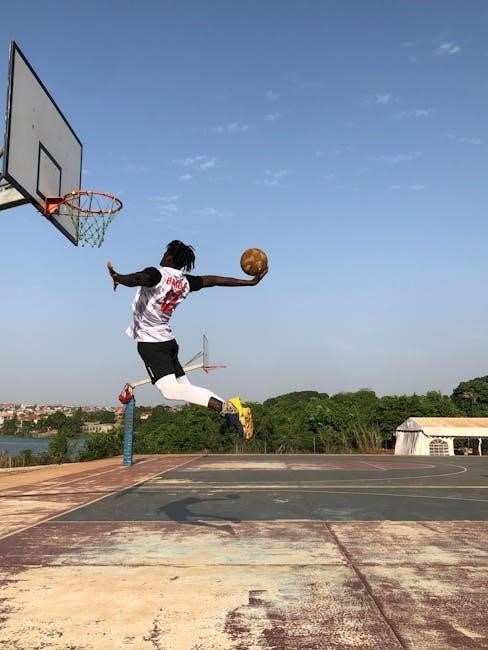A well-structured youth speed and agility training program enhances explosive power, quick directional changes, and overall athleticism, laying the foundation for long-term success in sports․
Importance of Speed and Agility in Youth Development
Speed and agility are crucial for youth athletes, enhancing performance in sports by improving reaction time, acceleration, and directional changes․ These skills also reduce injury risks and boost overall physical fitness․ Developing these abilities early fosters coordination, balance, and confidence, laying a strong foundation for lifelong athletic success and physical well-being․
Overview of the Training Program Structure
The training program is structured to meet the unique needs of youth athletes, focusing on age-specific development․ It begins with foundational skills, progressing through intermediate and advanced levels․ Each phase incorporates dynamic warm-ups, speed drills, agility exercises, and recovery strategies․ The program emphasizes proper technique, safety, and gradual progression to optimize performance and minimize injury risks, ensuring a well-rounded approach to athletic development․

Components of a Youth Speed and Agility Training Program
The program includes dynamic warm-ups, speed drills like high-knees and linear bounds, agility exercises such as cone drills and figure-8 crossovers, and strength-building activities․ These components are tailored to enhance acceleration, deceleration, and directional changes, ensuring a comprehensive approach to improving youth athletes’ performance and reducing injury risks through proper technique and progressive overload․
Key Elements for Building Speed
Building speed in youth athletes involves high-intensity interval training, explosive power exercises, and technique refinement․ Drills like high-knees, linear bounds, and resistance band sprints improve acceleration and stride efficiency․ Incorporating strength training enhances muscular power, while plyometric exercises boost explosiveness․ Proper running mechanics and deceleration techniques are emphasized to ensure safe, effective performance․ These elements are progressively overloaded to optimize speed gains without risking injury, fostering long-term athletic development․
Agility Development Through Specific Drills
Agility development focuses on enhancing quick directional changes, balance, and coordination through targeted drills․ Exercises like the 3-cone dribble, figure-8 crossover, and deceleration drills improve agility and control․ These drills simulate game-like scenarios, boosting reaction time and adaptability․ Incorporating reactive components, such as cone drills with verbal cues, further enhances agility in dynamic settings․ Proper technique and progressive overload ensure safe, effective development of agility in young athletes․ Consistency and variety in drills maximize improvement and engagement․
Age-Specific Training Considerations
Training must be tailored to the developmental stage of young athletes, adjusting drills and exercises to suit their age, strength, and coordination levels effectively․
Customizing Drills for Different Age Groups
Drills must be adapted to suit the physical and cognitive development of athletes across different age groups․ For younger athletes, focus on foundational movements like balance and coordination․ As athletes mature, introduce more complex agility drills, such as cone exercises and reactive training․ Ensure exercises are age-appropriate, with gradual progression to avoid overloading young athletes․ This tailored approach fosters skill development and keeps training engaging and effective for all ages․
Progressive Overload in Youth Training
Progressive overload involves gradually increasing the intensity of exercises to enhance performance․ For youth athletes, this may include adding resistance, increasing speed, or extending drill duration․ Implementing this safely ensures continuous improvement without risking injury․ Coaches should monitor progress and adjust challenges accordingly, ensuring athletes build strength and agility incrementally while maintaining proper technique and engagement․ This method supports long-term development and keeps training dynamic and effective․ Always prioritize age-appropriate adjustments to foster growth․

Safety and Injury Prevention
Ensuring athlete safety is crucial․ Proper warm-ups, cool-downs, and hydration are essential․ Supervision and appropriate equipment help prevent injuries, fostering a secure training environment for young athletes․
Warm-Up and Cool-Down Routines
A proper warm-up prepares young athletes for training, reducing injury risk․ Dynamic stretches like leg swings and high knees activate muscles, while light cardio boosts heart rates․ Mobility exercises for hips and ankles improve flexibility․ Cool-downs with static stretches and walking aid recovery, preventing soreness․ These routines are essential for safe and effective speed and agility sessions, ensuring athletes are prepared and recovered․
Proper Technique to Avoid Injuries
Emphasizing proper technique is crucial for injury prevention in youth speed and agility training․ Athletes should focus on maintaining good posture, bending at the knees, and avoiding overextension․ Drills like single-leg hops and lateral shuffles teach balance and control․ Coaches should provide feedback to ensure athletes use correct form, reducing the risk of overuse or acute injuries․ Proper landing and deceleration techniques are especially vital to safeguard young athletes during dynamic movements․
Integrating Strength and Power Training
Strength and power training are essential for enhancing speed and agility in youth athletes, forming the foundation for explosive movements and overall athletic performance․
Role of Strength in Speed and Agility
Strength is the foundation for speed and agility, enabling youth athletes to generate power for explosive movements․ It improves muscle force production, essential for sprinting and quick directional changes․ A strong lower body and core enhance acceleration and deceleration, while upper body strength supports overall athleticism․ Incorporating resistance exercises and functional movements builds the necessary muscle power, directly translating to faster speeds and sharper agility on the field․
Power Exercises for Youth Athletes
Power exercises, such as box jumps, medicine ball throws, and plyometric drills, are essential for developing explosive force․ These exercises improve an athlete’s ability to generate quick, powerful movements, enhancing speed and agility․ Resistance bands and weighted vests can also be incorporated to increase intensity․ Proper technique and progression are crucial to ensure safety and effectiveness, helping young athletes build the strength and explosiveness needed for competitive sports․

Periodization and Progression
Periodization involves structuring training into phases, while progression ensures gradual intensity increases․ This approach prevents plateaus, optimizes performance, and minimizes injury risks for young athletes․
Planning Training Phases
Planning training phases involves dividing the program into specific cycles tailored to the athlete’s development stage․ Each phase focuses on building foundational skills, enhancing strength, and improving speed․ Coaches design short-term goals, ensuring progression from basic to advanced drills․ Periodization balances intensity and recovery, preventing burnout and fostering steady improvement over time․ This structured approach ensures young athletes achieve peak performance safely and effectively․
Adapting Drills as Athletes Improve
As athletes progress, drills should evolve to challenge their advancing skills․ Coaches can increase difficulty by adding cones, reducing recovery time, or incorporating multi-directional movements․ Advanced variations, such as reactive drills or sport-specific patterns, prepare athletes for real-game scenarios․ Progressive overload ensures continued improvement without plateaus․ Drills like 3-cone dribbles or figure-8 crossovers can be modified to suit skill levels, keeping training engaging and effective for long-term development․
Nutrition and Recovery for Young Athletes
Proper fueling, hydration, and balanced nutrition are essential for optimizing performance and recovery․ Adequate rest, sleep, and recovery strategies help young athletes recharge for consistent growth and development․
Fueling for Optimal Performance
A balanced diet rich in carbohydrates, proteins, and healthy fats is essential for young athletes to sustain energy and support muscle growth․ Proper hydration and timing of meals around training sessions are critical․ Adequate nutrition ensures athletes can perform at their best, recover efficiently, and maintain consistent progress in their speed and agility training programs․ A well-planned nutrition strategy is vital for maximizing athletic potential and overall health․
Recovery Strategies
Proper recovery is crucial for young athletes to avoid overtraining and enhance performance․ Strategies include adequate hydration, sufficient sleep, and balanced nutrition to replenish energy stores․ Foam rolling and stretching help reduce muscle tension, while rest days allow the body to heal․ Active recovery, such as light swimming or cycling, promotes blood flow without excessive strain․ Consistent recovery practices prevent injuries, ensuring athletes can maintain intensity and achieve long-term progress in their training programs․
Mental and Emotional Development
Building mental toughness and emotional resilience is vital for young athletes․ Confidence, focus, and a growth mindset foster better performance and perseverance through challenges․
Building Confidence Through Training
Confidence is a cornerstone of youth athletic development․ Through achievable goals, positive reinforcement, and celebrate progress, young athletes gain self-belief․ Fun, engaging drills like high-knee sprints and agility ladder exercises foster success, while tailored challenges encourage mastery․ This supportive approach helps athletes embrace their potential, fostering resilience and a winning mindset that extends beyond the field․
Mental Agility and Focus Exercises
Mental agility and focus are crucial for young athletes to react quickly and make sharp decisions․ Exercises like reaction drills, cognitive games, and visual training enhance concentration․ Drills such as cone dribbles and figure-8 crossovers challenge both physical and mental quickness, improving coordination and processing speed․ These activities help athletes stay alert and adapt seamlessly during games, boosting overall performance and mental sharpness․

Tools and Resources for Parents and Coaches
Provide parents and coaches with online courses, practical tools, and expert guidance to enhance youth athletes’ speed and agility․ Utilize the F․A․S․T․ Speed and Agility System for effective drills and games․
Recommended Drills and Exercises
Effective drills include the Deceleration Drill, 3-Cone Dribble, Figure 8 Crossover, and High-Knee exercises․ These improve speed, agility, and coordination․ The F․A․S․T․ Speed and Agility System offers a comprehensive library of drills for all skill levels, focusing on balance and functional movement․ Incorporating these exercises into a structured program ensures well-rounded development for young athletes, enhancing their performance and confidence in various sports․
Tracking Progress and Providing Feedback
Regularly tracking an athlete’s progress through speed tests, agility assessments, and strength metrics ensures tailored development․ Coaches should provide constructive feedback, highlighting improvements and areas for growth․ Utilizing video analysis and performance data helps athletes visualize their progress, fostering motivation and refinement․ Consistent monitoring and positive feedback create a supportive environment, encouraging young athletes to reach their full potential effectively․
